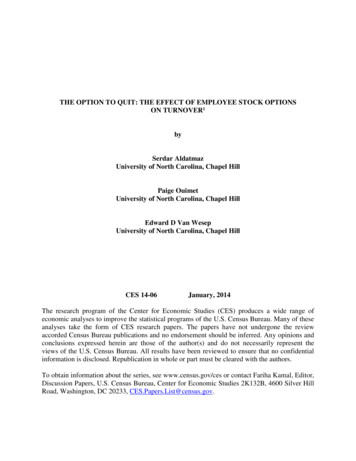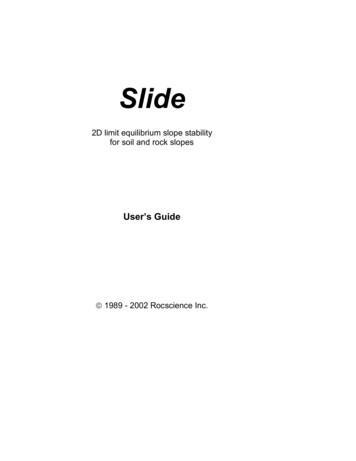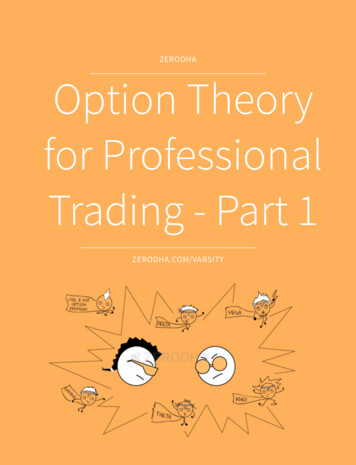
Transcription
THE OPTION TO QUIT: THE EFFECT OF EMPLOYEE STOCK OPTIONSON TURNOVER1bySerdar AldatmazUniversity of North Carolina, Chapel HillPaige OuimetUniversity of North Carolina, Chapel HillEdward D Van WesepUniversity of North Carolina, Chapel HillCES 14-06January, 2014The research program of the Center for Economic Studies (CES) produces a wide range ofeconomic analyses to improve the statistical programs of the U.S. Census Bureau. Many of theseanalyses take the form of CES research papers. The papers have not undergone the reviewaccorded Census Bureau publications and no endorsement should be inferred. Any opinions andconclusions expressed herein are those of the author(s) and do not necessarily represent theviews of the U.S. Census Bureau. All results have been reviewed to ensure that no confidentialinformation is disclosed. Republication in whole or part must be cleared with the authors.To obtain information about the series, see www.census.gov/ces or contact Fariha Kamal, Editor,Discussion Papers, U.S. Census Bureau, Center for Economic Studies 2K132B, 4600 Silver HillRoad, Washington, DC 20233, CES.Papers.List@census.gov.
AbstractWe show that in the years following a large broad-based employee stock option (BBSO) grant,employee turnover falls at the granting firm. We find evidence consistent with a causal relationby exploiting unexpected changes in the value of unvested options. A large fraction of thereduction in turnover appears to be temporary with turnover increasing in the 3rd year followingthe year of the adoption of the BBSO plan. We also find that the effect of BBSO plans is largerat market leaders, identified as firms with high industry-adjusted market-to-book ratios, marketshare or industry-adjusted profit margins, as measured at the time of the grant.Keyword: Employee stock options, turnoverii1All Authors: Campus Box 3490, McColl Building, Kenan-Flagler Business School, University of North Carolina,Chapel Hill, NC 27599. The authors can be reached via email at the following addresses:Serdar Aldatmaz@unc.edu; paige ouimet@unc.edu; and vanwesee@kenan-flagler.unc.edu. We thank Jed DeVaro,Radhakrishnan Gopalan, Shimon Kogan, and conference participants at the 2012 WFA Meetings in Las Vegas, 2012FIRS meetings in Minneapolis, 2011 Beyster Conference on Employee Ownership, 2011 Census Research DataCenter Conference and seminar participants at the University of North Carolina. We also thank Bert Grider andClint Carter for their diligent assistance with the data and clearance requests. Monica Wood, Mark Curtis and GangZhang provided superb research assistance. The research in this paper was conducted while the authors were SpecialSworn researchers of the U.S. Census Bureau at the Triangle Census Research Data Center. Any opinions andconclusions expressed herein are those of the author(s) and do not necessarily represent the views of the U.S. CensusBureau. All results have been reviewed to ensure that no confidential information is disclosed. This research usesdata from the Census Bureau's Longitudinal Employer Household Dynamics Program, which was partiallysupported by the following National Science Foundation Grants SES-9978093, SES-0339191 and TR0427889;National Institute on Aging Grant AG018854; and grants from the Alfred P. Sloan Foundation.
When firms grant broad-based employee stock options (BBSOs), they provide an incentive foremployees to remain with the firm until those options vest. 2 This suggests that BBSO grantsshould be associated with turnover reductions at granting firms. It is unclear, however, whetherwe would expect to see an effect in practice. First, it is common for competitors to poachemployees with options by granting a signing bonus to “make the employees whole”. In thiscase, BBSOs impose costs on competitors, but do not affect turnover. Second, as optionseventually vest, a reduction in turnover may be temporary, as employees merely delay joiningcompetitors until after their options vest. We exploit a large panel of establishment-level data toshow that turnover is reduced following the granting of BBSOs, and that the relationship appearscausal.We document that this reduction in turnover is temporary, to a great extent. After theoptions vest, we observe an increase in turnover nearly comparable in magnitude to the initialreduction. As such, it appears that BBSO grants are primarily delaying, as opposed to preventing,turnover. The increase in turnover once the options vest suggests that the mechanism throughwhich BBSO grants reduce turnover is associated with anticipation of a deferred compensationaward as opposed to feelings of greater loyalty towards the firm following the granting of stockbased compensation.We also find that BBSO plans are associated with stronger reduction in turnover in upmarkets, when growth options are high and retaining key employees is likely to be especiallyvaluable. We also find that the reduction in turnover is larger at market-leading firms. Firms that2A BBSO plan is a grant of stock options to a broad set of a firm’s employees, rather than solely to executives. Aswith executive options, strike prices are typically at par when the options are granted, and options vest over time.The average vesting period is three to four years (Crimmel and Schildkraut, 2001, Oyer and Schaefer, 2005), butoptions may not expire for several years after vesting. The 2000 National Compensation Survey found that optionsexpire 8.9 years after they are granted, on average. A more detailed review of the institutional details and usage ofBBSO plans can be found in Aldatmaz and Ouimet (2011).2
have a high industry-adjusted market-to-book ratio, high market share, or high industry-adjustedprofit margin at the time of the BBSO grant benefit the most from the issuance of employeestock options, suggesting complementarity between option grants and market leadership.Turnover is important. The direct costs of turnover are high: Hansen (1997) estimates thatthe cost of hiring and training a new worker equals 150% to 175% of her annual pay. Theindirect costs are high as well: Brachet and David (2011) find that turnover accounts for twice asmuch organizational forgetting as the more traditionally understood skill depreciation. Consistentwith these facts, firms are placing an increasing emphasis on reducing turnover.3Theory suggests that BBSOs are a natural solution. Typically, these options vest in 3years (Crimmel and Schildkraut, 2001, Oyer and Schaefer, 2005), and an employee who departsbefore her options have vested will forfeit their value. Furthermore, as Oyer (2004) shows,insofar as her outside employment opportunities are likely to increase when stock prices arehigher, the incentives provided by BBSOs against quitting are likely to be stronger when quittingis more appealing.We connect quarterly, establishment-level Census data on turnover with ExecuComp dataon stock option grants to estimate the effect of implementing a broad based stock option plan onemployee turnover. In the years following a large BBSO grant, turnover falls at the grantingfirm. We document evidence consistent with causality by exploiting exogenous variation in thevalue of unvested BBSO grants. If the existence of unvested options reduces turnover, then theeffect should be larger when the firm's stock price rises following the option grant, therebyincreasing the value of the unvested options. While we may observe this effect in the data, it isnot sufficient evidence that the BBSO grant is causing reduced turnover. If a firm’s stock price is3This emphasis on turnover is evidenced by the increasing frequency of managerial contracts providing a bonus ifturnover is kept below a specified level. See, for 22614255.html, accessed on November 7, 2012.3
predictable for the manager establishing the BBSO plan, then a variety of omitted variablescould alternatively explain such results.Thus, we instead focus on market returns which occur after the option grant. To theextent that own-firm returns are correlated with market returns, a firm’s option values willincrease when market returns are high. Moreover, market-wide returns are presumablyunpredictable for the manager. This effect should be stronger at firms whose stock price is highlycorrelated with their peers and, indeed, we show that this is the case.While the primary goal of the paper is to document the effect of BBSO plans on turnover,we have two sets of additional results of interest to economists. First, we confirm resultsconsistent with the theory of Oyer (2004) that BBSOs are especially valuable in reducingturnover because the “carrot” they provide adjusts to the temptation to quit that employees face.We show that BBSOs, on average, lead to relatively greater turnover reductions followingpositive market returns. This is important because the loss of valuable employees is presumablymore costly following positive market returns.4Second, we find that turnover is more affected by BBSOs when the firm is a marketleader or has greater growth opportunities. This may be surprising, because more successfulfirms have lower turnover without BBSOs, leaving less scope for turnover reductions. Theseresults suggest complementarity between explicit and implicit retention incentives, and supportCore and Guay (2001)’s finding that firms with greater growth options are more likely toimplement BBSO plans.Prior work has suggested that BBSOs can improve firm performance by better aligningemployee incentives, conserving cash, screening employees, and reducing turnover. Core and4Hiring is more difficult when labor markets are tight, suggesting that direct turnover costs are likely higher in goodtimes.4
Guay (2001) find evidence that firms with higher growth opportunities, high capital needs, andlower access to capital markets use BBSO plans more. Based on this evidence, they concludethat aligning incentives, conserving cash and retaining employees drive the implementation ofBBSO plans. Ittner, Lambert, and Larcker (2003) study new economy firms and argue thatBBSO plans are used as a substitute for more expensive means of monitoring employees. Carterand Lynch (2004) show that firms that re-price options subsequently experience lower turnover,as compared to a matched set of firms, where forfeited in-the-money options are used as a proxyfor turnover. Oyer and Schaefer (2005) calibrate an agency model and conclude that screeningemployees and reducing turnover can justify the implementation of BBSO plans. Bergman andJenter (2007) find evidence that BBSO plans are most common among firms with superior priorstock performance, supporting their theory that BBSO plans might be justified as a means toscreen employees based on their sentiment about the company’s prospects. Kedia and Rajgopal(2009) find evidence that the implementation of BBSO plans might be motivated by the grantingbehavior of peer firms. Blasi, Freeman, Mackin, and Kruse (2010) find that workers owningstock options report that they are less likely to look for a new job. Lastly, Hochberg and Lindsey(2010) explore the relationship between BBSO plans and subsequent firm operatingperformance. Instrumenting for the decision to adopt a BBSO plan with peer firms’ BBSOimplementation, they find that BBSO plans lead to superior operating performance.While reducing turnover has been suggested as one motivation, among many others, insome of these studies, none of them has tested the claim directly. In this paper, we provideevidence that there is indeed a negative relationship between BBSO plans and employeeturnover. We document evidence suggesting this relationship is causal, thereby supporting theclaim that retaining employees is one of the reasons why companies implement BBSO plans.5
Section I presents a description of the data used in our analyses and some summarystatistics. Section II includes our baseline results and some analyses of the effect of BBSO planson turnover in up versus down markets. In Section III, we analyze the effectiveness of BBSOs inreducing turnover as we vary firm attributes and Section IV concludes. Definitions of dependentand independent variables in our analyses can be found in Table 1.I DataWe use four primary data sources in the analysis. We use two databases from the USCensus Bureau. The Longitudinal Employer-Household Dynamics (LEHD) database containsinformation on hiring and employment at U.S. establishments and the Longitudinal BusinessDatabase (LBD) contains information about establishment characteristics, including ultimateowner. We identify BBSO plans through Standard and Poor’s ExecuComp database. Compustatprovides information on firm characteristics. We discuss each in turn.A. Longitudinal Employer-Household Dynamics DataThe LEHD program has created a unique panel database matching employees toemployers and tracking the relationship over time. The data are primarily derived from stateunemployment records and contain information on employee age, gender, wages, hiring, anddeparture dates. 5 The data also include the employer’s geographic location and industry. Thedata cover all establishments within a state, once the state is covered by the LEHD program. An5See Abowd et al (2009) for more detail.6
establishment6 is identified as any separate geographic address at which at least one employeeworks. The panel begins in 1992 for several states and the coverage of states increases over time.We use the LEHD to estimate employee turnover. Employee turnover includes allvoluntary and involuntary departures from a firm, and is estimated as:((() ))(1)where T is turnover, H is the number of new hires and E is the level of employment, at firm i,establishment j, and at the beginning of quarter t. Turnover covers both full-time and part-timeworkers. We limit our sample to full quarter employees, defined as workers employed over theprevious quarter, as these employees are most likely to be granted stock options. Turnover isestimated at the establishment-level and is measured quarterly. The LEHD reports the hiring,separations and earnings of workers in each quarter by age and gender.It is worth discussing two simple cases to illustrate how turnover is defined. In the firstcase, suppose the firm does not change the number of employees at an establishment in quarter t,but one worker quits and is replaced. Thenand, so. As should be intuitive, a fraction 1/E of the workforce turns over in this case. In thesecond case, the firm hires one more person at the establishment without anybody departing.Thenand, so. This firm has expanded, notexperienced turnover.6A business establishment is part of a firm defined by having a particular geographic location. For example, a lawfirm with an office in Boston and an office in New York would have two business establishments. Likewise, amanufacturing firm with three different plants operating in different locations, e.g., two in Illinois and one inWisconsin, would have three business establishments.7
Wage data in the LEHD are available for all employees at a given establishment as wellas in breakdowns by age and gender cohorts. The information included in employee earningsincludes base salary as well as any other payment taxed as ordinary income, such as bonuses.B. Longitudinal Business DatabaseThe LBD is a panel data set that tracks all U.S. business establishments with at least oneemployee or positive payroll. The database is formed by linking years of the standard statisticalestablishment list (SSEL) maintained by the Internal Revenue Service of the U.S. TreasuryDepartment. The SSEL contains the federal employer identification number (EIN), physicaladdress, and name of each business establishment that files tax returns in the U.S.The LBD contains information on the number of employees working for an establishmentand total annual establishment payroll.7 The LBD allows us to identify establishment age, basedon when the establishment enters the database. 8 The LBD also identifies the owner of allestablishments. Finally, we use the unique establishment-level identifier assigned by the LBD,the lbdnum, to track firms over our sample period 1994-2005.Business establishments in the LBD are linked to ExecuComp and Compustat through theCompustat-SSEL bridge.C. ExecuComp Data78See Jarmin and Miranda (2002) for more information.Establishment age is truncated at 30 years in the data.8
To estimate the size of broad-based stock option plans, we follow a methodology similarto Oyer and Schaefer (2005). First, we obtain data on the top-five executives’ option holdingsand option grants from the Standard & Poor (S&P) ExecuComp database. ExecuComp alsoprovides the percentage of total employee option grants assigned to the top-five executives,allowing us to calculate the value of stock options granted to all employees at the firm. Becausemost firms have executives outside the top five, and we wish to subtract their option grants aswell, we assume that non-top five executives receive grants equal to 10% of the average grantawarded to the 2nd through 5th executives. Our estimate of options granted to non-executiveemployees is, therefore, equal to total grants minus the sum of 1) grants awarded to top 5executives and 2) ten percent of the average grant made to the top 5 group after subtracting thegrant made to the CEO. This variable is restricted to being positive.We use an indicator variable to identify those firms with the largest BBSO plans. Wedefine a large BBSO plan as occurring at firm i at time t if the inflation-adjusted Black-Scholesdollar value per employee of new BBSO option grants at firm i in year t exceeds the 95thpercentile of the sample distribution. Given the vesting requirements typically associated withoption grants, we assume that a large BBSO grant will impact turnover for three years. As such,the BBSO variable is equal to 1 if the firm had a large BBSO grant this year, last year or the yearbefore, and 0 otherwise.In defining the BBSO variable, there were three important considerations. First, we needto capture truly broad-based option grants as turnover is being broadly estimated. Therefore, werestrict attention to the largest grants where it becomes increasingly unlikely that such grantscould be allocated to just a small group of top executives.9
Second, we must make sure that the indicator represents whether employees ownunvested options, not simply whether they were issued options in a particular year. Because it iscommon for options to vest on a three year schedule, we assign a value of 1 to our baselinevariable so long as options were granted in the year of the observation, or in the prior two years.As vesting schedules may allow partial vesting prior to three years, we may imagine that theeffect of an option grant is decreasing over time. To allow for this, we also sometimes performregressions with year-specific indicator variables.Third, we must be sure that our variable is capturing large spikes in option issuance. Thatis, we must be sure that we are not capturing regular issuances from the same firms over time.Figure 1 shows that roughly 2/5 of firms that have at least one BBSO plan in our data have onlyone. About 1/4 have two. Figure 2 shows that, of the firms with two BBSO grants in our data,about 2/3 issue the BBSOs in back-to-back years, which essentially amount to one large grantover two years. We are therefore confident that our BBSO indicator variable is capturing grantsthat are unusual for the firm in question, and broad-based.D. CRSP and CompustatWe use Compustat to identify firm characteristics and CRSP to measure firm stockperformance. We use several control variables that have been suggested in the literature to affectturnover: book leverage, profitability, and size (log of total assets) from Compustat, and firmbuy-and-hold stock returns, stock volatility, and sigma from CRSP.E. Linking data10
The business establishments in the LEHD can be linked to the business establishments inthe LBD using crosswalk files provided by the US Census. These files identify businessestablishments in the LEHD which can be matched to business establishments in the LBD basedon EIN, industry, state, and county variables. However, two issues arise from matching. First,due to inconsistency in reporting, not all business establishments in the LEHD can be matched tothe LBD using EIN, industry, state and county. Second, if a firm has multiple establishmentslocated in the same county and operating in the same line of business, we cannot do a one to onematch. Instead, we aggregate the LEHD and LBD data to a “meta-establishment” which includesall of the firm’s establishments in that state, county and industry.We use an iterative process to complete our matching. In each iteration, we identify amatch using EIN, state, county and some definition of industry. In the first iteration, we use themost stringent definition of industry, 4-digit SIC (for 1992-2001) or 6-digit NAICS (for 20022005). For those establishments not matched in the first iteration, we then attempt a match againusing EIN, state and county but now using 3-digit SIC or 4-digit NAICS. In the third iteration weuse 2-digit SIC and NAICS codes. In the fourth iteration we use 1-digit SIC or NAICS codes. Inthe final iteration, we match only on EIN, state and county.Table 2 presents summary statistics for our dataset and for the sub-sample of firms thathave recently implemented a large BBSO plan. 9 Issuing firms are smaller, on average, asmeasured by assets and employees, but are of more similar market capitalization to firms in thebroader sample. They are less levered, and feature considerably higher market-to-book ratios and9Summary statistics in Tables 2 and 3 are created using all ExecuComp data, including observations which cannotbe matched to Census data and are dropped from the Tables 4- 10. We report these statistics using the full sample toavoid the more significant disclosure process associated with disclosing means and medians of confidential Censusdata. Once we are assured of no further changes to the sample, our intention is to clear the results using the samesample as in Tables 4 to 10.11
greater stock price volatility. These properties of large BBSO issuers are consistent with thosefound in the literature. Table 3 reveals that large issuers are found in a wide variety of industries,most commonly business services, pharmaceuticals, and computers and electronic equipment.II The Effect of BBSO Plans on TurnoverWe begin by providing evidence that firms experience a decrease in turnover after issuingstock options to employees. As shown in Table 4, turnover is significantly lower at firms thathave recently issued a large BBSO grant to employees. Quarterly turnover in the full sample is5.7%, 10 while quarterly turnover in the sub-sample of large BBSO issuing firms is 2.9%,approximately half of the level in the full sample.These data are suggestive that a BBSO can reduce turnover, but are not conclusive. Firmsimplementing a BBSO plan are, both observably and un-observably, different from firms that donot implement such plans. In Table 5, we attempt to control for cross-sectional and time-seriesvariation in the type of firm implementing a BBSO plan by estimating variants of the followingequation:(2)is our indicator for whether a firm has recently implemented a large BBSOplan,are macro-, firm-, or establishment-level controls, lagged one period, andareestablishment fixed-effects. We use quarterly establishment-level observations, and cluster ourstandard errors at the firm level.10Average turnover in our sample is lower than Bureau of Labor Statistics estimates of 9%-10% in the US over thesame period, calculated as the ratio of monthly turnover (approximately 4.6 million) to average employment(approximately 140 million). This discrepancy is likely due to the facts that (i) our data only include workersemployed at the establishment for at least three months (full quarter employees), and (ii) our data only includesworkers at large public firms. We report an employee-weighted average as this facilitated Census disclosure.12
In column 1 of Table 5, Panel A, we include the BBSO indicator variable with additionalcontrols and observe a negative and significant coefficient on the BBSO indicator. Thus, theobserved reduction in turnover following the adoption of a BBSO plan reported in Table 4appears to be due to neither a correlation of BBSO plan implementation with time-varying firmcharacteristics, nor changes in unemployment.In column 2, we include establishment fixed effects, which control for time-invariantdifferences at establishments with BBSO plans and those without. We continue to find thatturnover at an establishment is reduced following the adoption of a BBSO plan. This result alsoholds with year fixed effects (column 3).11 On average, firms experience a 0.48% - 0.52% dropin quarterly turnover in the three years following the implementation of a BBSO plan. Note thatthis is an absolute change: if a typical firm in this group experiences 5% turnover, then the effectis to reduce the turnover rate by 10%.12These results systematically under-estimate the effect of such plans for two reasons. First,our measure of turnover includes all employees, while it is unlikely that even 50% of employeesreceive BBSO shares. As such, the effect on employees who receive the treatment (get shares)should be at least twice as large as the overall effect estimated. Second, selection issues may biasour results. For example, perhaps in an attempt to stem a tide of departures, managers adoptBBSO plans when they expect turnover to increase. In this case, the coefficient on our BBSOdummy will underestimate the magnitude of the effect.Establishment fixed effects control for time-invariant establishment characteristics. Analternative approach is to include lagged turnover,, as in Carter and Lynch (2004). Incolumn 4, we include lagged turnover but drop establishment fixed effects. As in earlier11In column 3, we drop the control variable, unemployment, because it is an annual variable and is unidentifiedonce we add year fixed effects.129.6% 0.0048/0.05 and 10.4% 0.0052/0.05.13
specifications, we observe a negative and statistically significant coefficient on our BBSOdummy variable.One might expect that if a firm is doing particularly well, turnover would be lower, asimplicit retention incentives – like the higher likelihood of promotion and lower likelihood oflayoffs – should be stronger. In column 5, we add the firm’s lagged industry-adjusted buy-andhold returns to our regression to investigate the effect of firm-level success. While the negativecoefficient suggests that this intuition is correct, it is not statistically significant.In Panel B, we investigate the effect of BBSO implementation at an establishment ineach year after issuance. BBSOs should reduce turnover while they remain unvested and,potentially, increase turnover in the year following vesting, as employees who postponed adeparture to capture value from their options may now be more likely to quit. While we do notobserve the vesting period(s) for a given firm’s BBSO issue, this period is typically less than orequal to three years. Year 0 is the year of the large BBSO grant. Year 1 is the year after a largeBBSO grant. Year 2 (3) captures two (three) years after the large BBSO grant. If all optionsvest in the first three years (years 0-2 in our definition) then year 3 will reflect the first yearwhere all options are assumed to have vested.In column 1, we see that while the coefficient in year zero is negative, it is notstatistically significant. The more modest effect may be driven by the fact that the options willnot vest for several years, making them less important to decisions today. In years one and two,the effect is clearly negative: turnover is reduced in the two years following the year of theBBSO grant. As one would expect if options partially vest in each year, the effect in year three isless than in year two, though the difference is not statistically significant. In the third year afterthe year of the grant, when most or all of the options are likely to be vested, we see a significant14
increase in turnover, consistent with the view that employees time their departures to take placeafter full vesting. Therefore, managers should expect an increase in turnover after vesting, andplan accordingly.In columns 2 and 3, we repeat the regression in column 1 but use only a subset of thefirms with BBSO plans. For firms which have a BBSO at any point in time, we require that thefirm have non-missing information for years 0, 1, 2, and 3. We retain all control firm-yearobservations used in column 1 and include additional control firm-year observations that werepreviously dropped from the sample due to missing data for lag turnover.13 Column 2 includescontrols for national unemployment rates. Column 3 includes year fixed effects. We findsimilar results, indicating that differences in the sample of BBSO firms reflected in each BBSOyear dummy was not driving the result in column 1.The reversal indicates that the majority of the effect of BBSO plans on turnover is simplyto delay turnover. We find, on average, that 87% of the reduction in turnover observed in the firstthree years is reversed in the subsequent year. Furthermore, a number of firms issue multiplelarge BBSO grants. To the extent that a second large BBSO grant timed years after the first grantreduces future turnover, we are under-estimating the reversal. In unreported results, we repeatthe regression in column 2 but exclude firms with multiple BBSO grants and find an even moredramatic reversal.14Across all regressions, three further results are apparent. First, as previously shown byLane, Isaac, and Stevens (1996) and Porter and Steers (1976), large
1 All Authors: Campus Box 3490, McColl Building, KenanFlagler Business School, University of North Carolina, - Chapel Hill, NC 27599. The authors can be reached via email at the following addresses: Serdar_Aldatmaz@unc.edu; paige_ouimet@unc.edu; and vanwesee@kenan-flagler.unc.edu. We thank Jed DeVaro,











